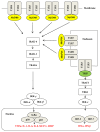RAGE and TLRs as Key Targets for Antiatherosclerotic Therapy
- PMID: 30225265
- PMCID: PMC6129363
- DOI: 10.1155/2018/7675286
RAGE and TLRs as Key Targets for Antiatherosclerotic Therapy
Abstract
Receptor for advanced glycation end-products (RAGE) and toll-like receptors (TLRs) are the key factors indicating a danger to the organism. They recognize the microbial origin pathogen-associated molecular patterns (PAMPs) or damage-associated molecular patterns (DAMPs). The primary response induced by PAMPs or DAMPs is inflammation. Excessive stimulation of the innate immune system occurs in arterial wall with the participation of effector cells. Persistent adaptive responses can also cause tissue damage and disease. However, inflammation mediated by the molecules innate responses is an important way in which the adaptive immune system protects us from infection. The specific detection of PAMPs and DAMPs by host receptors drives a cascade of signaling that converges at nuclear factor-κB (NF-κB) and interferon regulatory factors (IRFs) and induces the secretion of proinflammatory cytokines, type I interferon (IFN), and chemokines, which promote direct killing of the pathogen. Therefore, signaling of these receptors' pathways also appear to present new avenue for the modulation of inflammatory responses and to serve as potential novel therapeutic targets for antiatherosclerotic therapy.
Figures


Similar articles
-
Insight into the mechanisms regulating immune homeostasis in health and disease.Asian Pac J Allergy Immunol. 2011 Mar;29(1):1-14. Asian Pac J Allergy Immunol. 2011. PMID: 21560483 Review.
-
The role of RAGE in host pathology and crosstalk between RAGE and TLR4 in innate immune signal transduction pathways.FASEB J. 2020 Dec;34(12):15659-15674. doi: 10.1096/fj.202002136R. Epub 2020 Nov 1. FASEB J. 2020. PMID: 33131091 Free PMC article. Review.
-
Mechanisms and pathways of innate immune activation and regulation in health and cancer.Hum Vaccin Immunother. 2014;10(11):3270-85. doi: 10.4161/21645515.2014.979640. Hum Vaccin Immunother. 2014. PMID: 25625930 Free PMC article. Review.
-
RAGE and TLRs: relatives, friends or neighbours?Mol Immunol. 2013 Dec;56(4):739-44. doi: 10.1016/j.molimm.2013.07.008. Epub 2013 Aug 14. Mol Immunol. 2013. PMID: 23954397 Review.
-
The role of damage- and pathogen-associated molecular patterns in inflammation-mediated vulnerability of atherosclerotic plaques.Can J Physiol Pharmacol. 2017 Oct;95(10):1245-1253. doi: 10.1139/cjpp-2016-0664. Epub 2017 Jul 26. Can J Physiol Pharmacol. 2017. PMID: 28746820 Review.
Cited by
-
TLRs and RAGE are elevated in carotid plaques from patients with moderate-to-severe obstructive sleep apnea syndrome.Sleep Breath. 2020 Dec;24(4):1573-1580. doi: 10.1007/s11325-020-02029-w. Epub 2020 Feb 20. Sleep Breath. 2020. PMID: 32076951 Free PMC article.
-
RAGE Differentially Altered in vitro Responses in Vascular Smooth Muscle Cells and Adventitial Fibroblasts in Diabetes-Induced Vascular Calcification.Front Physiol. 2021 Jun 7;12:676727. doi: 10.3389/fphys.2021.676727. eCollection 2021. Front Physiol. 2021. PMID: 34163373 Free PMC article.
-
Effect of Synthetic Peptides Identified in the Bullfrog Skin on Inflammation and Oxidative Stress Control: An In Vitro Analysis.Molecules. 2025 May 20;30(10):2223. doi: 10.3390/molecules30102223. Molecules. 2025. PMID: 40430395 Free PMC article.
-
Calcium-Binding Protein S100A4 Is Upregulated in Carotid Atherosclerotic Plaques and Contributes to Expansive Remodeling.J Am Heart Assoc. 2020 Sep 15;9(18):e016128. doi: 10.1161/JAHA.120.016128. Epub 2020 Sep 11. J Am Heart Assoc. 2020. PMID: 32914661 Free PMC article.
-
Inhibition of Toll-like Receptors Alters Macrophage Cholesterol Efflux and Foam Cell Formation.Int J Mol Sci. 2024 Jun 20;25(12):6808. doi: 10.3390/ijms25126808. Int J Mol Sci. 2024. PMID: 38928513 Free PMC article.
References
Publication types
MeSH terms
Substances
LinkOut - more resources
Full Text Sources
Other Literature Sources
Medical

